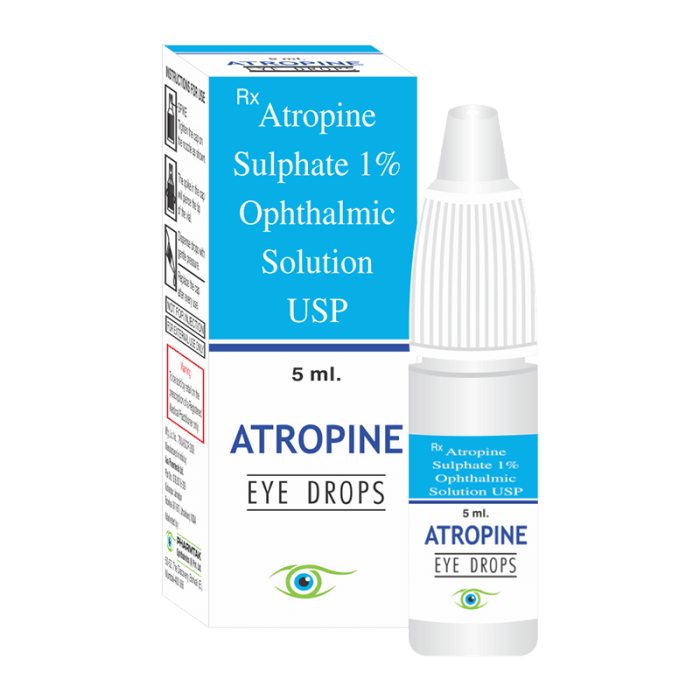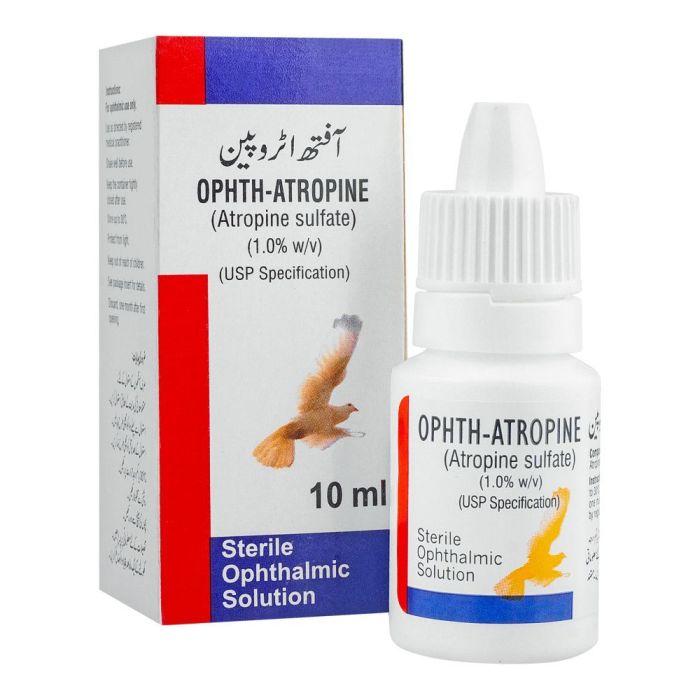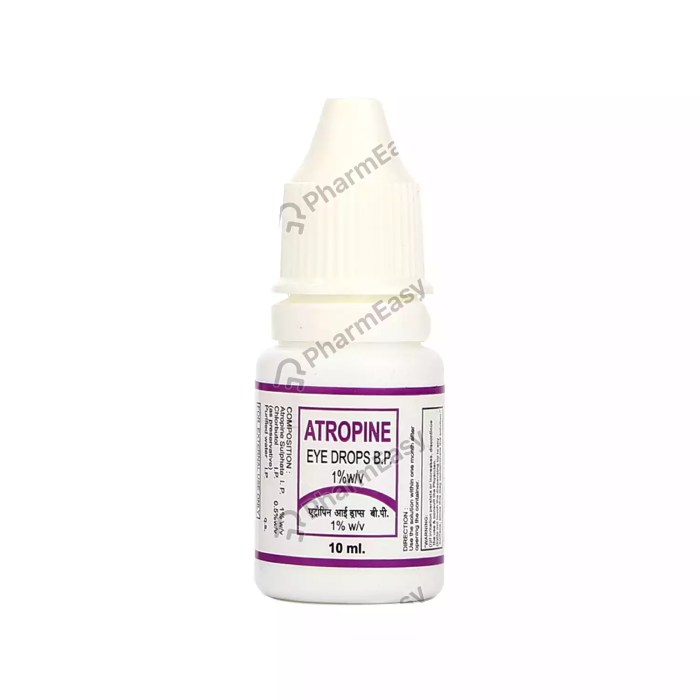Atropine eye drops, a potent medication, play a significant role in ophthalmology. These drops, containing the active ingredient atropine, work by temporarily paralyzing the muscles responsible for constricting the pupil, resulting in dilation. This dilation allows for a clearer view of the eye’s interior, aiding in various diagnostic procedures and treatments.
Atropine eye drops are prescribed for a variety of conditions, including mydriasis (pupil dilation) for eye examinations, treatment of certain types of uveitis (inflammation of the middle layer of the eye), and even to prevent amblyopia (lazy eye) in children. However, it’s crucial to understand the potential side effects and precautions associated with atropine eye drops, particularly for children and pregnant women.
Atropine Eye Drops

Atropine eye drops are a type of medication used to dilate the pupils of the eyes. This dilation, known as mydriasis, allows for better visualization of the inside of the eye during eye examinations. Atropine eye drops are commonly used by ophthalmologists and optometrists to diagnose and treat various eye conditions.
Chemical Composition
Atropine eye drops contain the active ingredient atropine, a naturally occurring alkaloid extracted from the belladonna plant (Atropa belladonna). Atropine is a parasympatholytic, meaning it blocks the action of the neurotransmitter acetylcholine at the parasympathetic nervous system receptors. This blockage leads to the dilation of the pupils.
Mechanism of Action
Atropine eye drops work by blocking the action of acetylcholine at the muscarinic receptors in the iris and ciliary muscle of the eye. Acetylcholine is a neurotransmitter responsible for constricting the pupil and controlling the focusing ability of the eye. By blocking acetylcholine, atropine prevents these actions, resulting in pupil dilation and a decreased ability to focus on near objects.
Forms of Atropine Eye Drops
Atropine eye drops are available in various forms and concentrations, including:
- Atropine Sulfate 1% Solution: This is the most common form of atropine eye drops used for pupil dilation. It is typically administered once or twice a day, depending on the specific medical need.
- Atropine Sulfate 0.5% Solution: This lower concentration of atropine is used for shorter-term pupil dilation, such as for eye examinations.
- Atropine Sulfate 0.25% Solution: This even lower concentration of atropine is used for situations where a longer-lasting effect is not required.
Uses of Atropine Eye Drops

Atropine eye drops are a common medication used in ophthalmology for various purposes. They work by blocking the action of acetylcholine, a neurotransmitter that constricts the pupil and focuses the eye. This effect leads to pupil dilation (mydriasis) and relaxation of the ciliary muscle, which helps to improve vision in certain conditions and facilitates ophthalmological examinations.
Medical Conditions Where Atropine Eye Drops Are Used
Atropine eye drops are used to treat a variety of medical conditions, including:
- Iritis and Uveitis: These conditions involve inflammation of the iris and uvea, respectively. Atropine eye drops help to dilate the pupil, reducing inflammation and pain.
- Myopia: Atropine eye drops can slow down the progression of myopia (nearsightedness) in children. This is because they reduce the amount of time the eye spends focusing on close objects, which is thought to contribute to myopia development.
- Accommodation Spasm: This condition causes blurry vision due to involuntary muscle spasms in the eye. Atropine eye drops help to relax the ciliary muscle, relieving the spasms and improving vision.
- Strabismus: Atropine eye drops can be used to treat strabismus (crossed eyes) by temporarily paralyzing the eye muscles, allowing the eyes to align correctly.
Use of Atropine Eye Drops in Ophthalmological Examinations
Atropine eye drops are frequently used in ophthalmological examinations to dilate the pupil and allow the doctor to view the back of the eye (fundus). This is essential for diagnosing various eye conditions, including:
- Retinopathy: This refers to damage to the retina, often caused by diabetes or high blood pressure.
- Glaucoma: This condition involves damage to the optic nerve, which can lead to blindness.
- Macular Degeneration: This condition affects the central part of the retina, causing blurred or distorted vision.
Pupil dilation allows the doctor to examine the retina, optic nerve, and other structures of the eye in detail, aiding in the diagnosis and management of these conditions.
Treatment of Specific Eye Conditions with Atropine Eye Drops
Atropine eye drops are used to treat specific eye conditions by targeting the underlying cause of the condition:
- Iritis and Uveitis: Atropine eye drops are used to dilate the pupil, reducing inflammation and pain. The dilation allows for better drainage of inflammatory fluid and reduces the pressure on the iris and uvea.
- Myopia: Atropine eye drops are used to slow down the progression of myopia in children. They work by reducing the amount of time the eye spends focusing on close objects, which is thought to contribute to myopia development.
- Accommodation Spasm: Atropine eye drops are used to relax the ciliary muscle, relieving the spasms and improving vision. This is because the ciliary muscle is responsible for focusing the eye, and its spasms can lead to blurry vision.
- Strabismus: Atropine eye drops can be used to treat strabismus by temporarily paralyzing the eye muscles, allowing the eyes to align correctly. This allows the brain to re-learn how to coordinate the eye movements, leading to improved alignment.
Administration and Dosage: Atropine Eye Drops
Atropine eye drops are typically administered by instilling a drop of the solution into the conjunctival sac of the affected eye. This procedure is straightforward but requires careful attention to ensure proper application and minimize the risk of side effects.
Dosage Guidelines
Dosage of atropine eye drops varies depending on the patient’s age, condition, and the specific formulation of the medication.
- Children: In children, atropine eye drops are typically prescribed in lower concentrations and dosages to minimize the risk of systemic side effects. The dosage may also vary based on the specific condition being treated. For example, in cases of strabismus (crossed eyes), a lower dosage may be used to avoid excessive dilation of the pupils.
- Adults: Adults may receive higher dosages of atropine eye drops depending on their condition and the severity of their symptoms.
Potential Side Effects and Precautions, Atropine eye drops
Atropine eye drops can cause several side effects, including:
- Pupil dilation: This is the most common side effect of atropine eye drops and can make it difficult to see in dim light.
- Blurred vision: Atropine eye drops can also cause blurred vision, particularly at close distances.
- Increased intraocular pressure: In some cases, atropine eye drops can increase intraocular pressure, which may be a concern for individuals with glaucoma.
- Systemic effects: In rare cases, atropine eye drops can be absorbed into the bloodstream and cause systemic side effects, such as dry mouth, flushing, and rapid heartbeat.
It is crucial to follow the instructions provided by your healthcare provider regarding the use of atropine eye drops.
Always wash your hands thoroughly before administering the eye drops.
To prevent contamination, avoid touching the tip of the dropper to your eye or any other surface.
Tilt your head back and pull down the lower eyelid to create a small pocket.
Gently squeeze the dropper to release a single drop into the conjunctival sac.
Close your eye gently and apply light pressure to the inner corner of your eye for about one minute to prevent the eye drops from draining out.
Atropine Eye Drops and Children
Atropine eye drops are a common treatment for various eye conditions in children, including strabismus (crossed eyes) and myopia (nearsightedness). However, it’s crucial to understand the specific considerations, potential risks, and benefits associated with using atropine eye drops in pediatric patients.
Safety and Efficacy
Atropine eye drops are generally safe and effective for children when used under the guidance of a healthcare professional. However, there are certain considerations that need to be addressed:
- Age and Development: The dosage and frequency of atropine eye drops can vary depending on the child’s age and developmental stage. Younger children may be more sensitive to the effects of atropine, so it’s essential to start with a lower dose and monitor their response closely.
- Underlying Conditions: Children with certain medical conditions, such as glaucoma or a history of allergic reactions to atropine, may not be suitable candidates for atropine eye drops. It’s crucial to inform the healthcare provider about any existing medical conditions before starting treatment.
- Potential Side Effects: Common side effects of atropine eye drops include blurred vision, sensitivity to light, and dry eyes. These side effects are usually mild and temporary. However, more serious side effects, such as increased heart rate and fever, can occur in rare cases. It’s important to report any unusual symptoms to the healthcare provider immediately.
Benefits of Atropine Eye Drops in Children
Atropine eye drops can offer several benefits for children with certain eye conditions:
- Strabismus (Crossed Eyes): Atropine eye drops can help improve alignment by temporarily paralyzing the eye muscles, allowing the brain to learn to use both eyes together. This can reduce the risk of amblyopia (lazy eye) developing.
- Myopia (Nearsightedness): Studies suggest that low-dose atropine eye drops may slow down the progression of myopia in children. The exact mechanism is not fully understood, but it may involve reducing the elongation of the eyeball.
Parental Supervision During Administration
Parental supervision is crucial during the administration of atropine eye drops to children. This ensures proper application, reduces the risk of accidental ingestion, and helps monitor for any side effects.
- Proper Technique: Parents should carefully follow the healthcare provider’s instructions for administering the eye drops. This includes washing hands thoroughly, tilting the child’s head back, gently pulling down the lower eyelid, and placing the drops in the conjunctival sac (the space between the eyelid and the eyeball).
- Supervision and Monitoring: Parents should supervise their child closely after administering the eye drops. They should monitor for any side effects, such as blurred vision, sensitivity to light, or changes in behavior. If any unusual symptoms occur, they should contact the healthcare provider immediately.
Interactions and Contraindications

Atropine eye drops can interact with other medications, and there are certain conditions that make it unsafe to use them. It is important to understand these interactions and contraindications to ensure safe and effective treatment.
Interactions with Other Medications
Atropine eye drops can interact with other medications, potentially leading to adverse effects. It is crucial to inform your doctor about all medications you are currently taking, including over-the-counter drugs, herbal supplements, and vitamins, before starting atropine eye drops.
- Anticholinergics: Atropine eye drops, being an anticholinergic itself, can enhance the effects of other anticholinergic medications, such as antihistamines, tricyclic antidepressants, and some antipsychotics. This can lead to increased side effects like dry mouth, constipation, blurred vision, and urinary retention.
- Monoamine Oxidase Inhibitors (MAOIs): Combining atropine eye drops with MAOIs can potentially increase the risk of adverse effects, such as confusion, agitation, and hallucinations. Therefore, it is crucial to avoid using atropine eye drops if you are taking MAOIs.
Contraindications
Atropine eye drops are not suitable for everyone. Certain conditions can make their use contraindicated.
- Glaucoma: Atropine eye drops can increase intraocular pressure, which can worsen glaucoma, a condition characterized by increased pressure inside the eye. Therefore, atropine eye drops are contraindicated in patients with glaucoma.
- Myasthenia Gravis: Myasthenia gravis is a neuromuscular disorder characterized by muscle weakness. Atropine can worsen muscle weakness in patients with myasthenia gravis.
- Prostatic Hyperplasia: Atropine can worsen urinary retention in patients with an enlarged prostate, known as prostatic hyperplasia.
- Hypersensitivity: Patients with a known allergy to atropine or any of its ingredients should avoid using atropine eye drops.
When to Avoid Atropine Eye Drops
It is important to avoid using atropine eye drops in the following situations:
- Pregnancy and Breastfeeding: The safety of atropine eye drops during pregnancy and breastfeeding has not been established. Therefore, it is generally recommended to avoid using atropine eye drops during these periods unless absolutely necessary.
- Driving or Operating Machinery: Atropine eye drops can cause blurred vision, which can impair your ability to drive or operate machinery. It is advisable to avoid these activities until your vision has returned to normal.
- Contact Lens Wear: Atropine eye drops can cause dryness and irritation, which can make it uncomfortable to wear contact lenses. It is recommended to remove contact lenses before administering atropine eye drops.
Atropine eye drops are a valuable tool in ophthalmology, offering numerous benefits in diagnosis and treatment. Understanding their mechanism of action, appropriate usage, and potential side effects is essential for informed patient care. With careful consideration and proper administration, atropine eye drops can effectively address various eye conditions while ensuring patient safety and optimal outcomes.
Atropine eye drops are commonly used to dilate the pupils, often for eye exams or to treat certain eye conditions. While atropine is used in the eyes, another common medication for ear infections is ofloxacin ear drops. Both medications are effective in their respective areas, and it’s important to consult with a healthcare professional to determine the appropriate treatment for any condition.